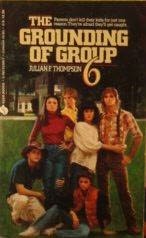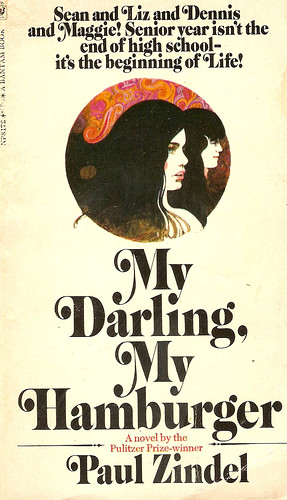 Well, that's one down. Two weeks ago, I spent a few pleasurable days with Madeline L'Engle's classic A Wrinkle in Time. Now comes the question - how does one write about these books for the Shelf Discovery Challenge? Whereas this one was an easy read because I a) have already read through it once, and b) already own it, I feel like it's the more challenging to write about because my opinions on it are already well formed, not to mention that Ms. Skurnick does a really fine job of writing A Wrinkle in Time, so good and spunky and true that it's almost a disservice to try to add anything to the topic, at least as far as Shelf Discovery goes...
Well, that's one down. Two weeks ago, I spent a few pleasurable days with Madeline L'Engle's classic A Wrinkle in Time. Now comes the question - how does one write about these books for the Shelf Discovery Challenge? Whereas this one was an easy read because I a) have already read through it once, and b) already own it, I feel like it's the more challenging to write about because my opinions on it are already well formed, not to mention that Ms. Skurnick does a really fine job of writing A Wrinkle in Time, so good and spunky and true that it's almost a disservice to try to add anything to the topic, at least as far as Shelf Discovery goes...The other books I chose deliberately because I had not read them, but in one way or another, I've always felt compelled to, either because they are long-staying YA classics or because their impact can be felt in great YA books of today or because there was something about them that sticks out so sharply, I could not ignore my interest (I'm looking at you, My Darling, My Hamburger). But A Wrinkle in Time I picked for a different reason, mostly out of sentiment, but not for the book itself. Rather, what the book has always reminded me of, what it has always been a symbol of, other than what is actually contained in the story, has been my mother's continual support and interest in my love of reading.
I've always been an avid reader - cliched, out-of-date slang insults for me could include bookworm, booknerd, etc. - but not necessarily of particularly distinguished taste. A lot of the stuff I read as an intermediate-level reader - ages six through 10 - were your common variety kids' junk read, maybe with some Boxcar Children or Roald Dahl or Lowis Lowry mixed in. I read a lot of The Babysitters Club. I read thin little paperbacks with sixth grade kids getting into mild trouble with their friends/family/school but nothing dire, nothing tragic, nothing impactful. I read some mysteries, mostly pointless stuff. I'm not completely deriding what I read at that age, but I didn't have an emphasis in anything classic. My mother tried to get me interested in Nancy Drew, but it seemed too old fashioned. I read the same first half of Little Women in the same green, hardbacked copy from the library, but never moved beyond the "little women's" childhood. I read a lot of books twice, three times, four times over. I thought about what I was reading, but not really beyond what I thought of the main character, what I thought of her/his family, what I thought of his/her friends. I was a greedy reader, but superficial in my understanding.
I don't look at my reading from then and think totally dismissively, or even that "ugh, look at all the crap I read then compared to the stuff I read now!" - if I'm honest, my taste has never been to pure classics or the upper echelon of literary fiction or the driest and most researched of contemporary non-fiction. I have certain basic requirements in what I read as an adult, and I hold these standards to everything I read, whether it be the children's books that are my professional life, or the occasional adult read that I use as valued breaks from the sometimes monotony of reading for the same demographics over and over again. But my basic requirements are just that - basic: I don't like stuff that is preachy, or wears its morals as some kind of necessary endorsement for the value of the book. I can't read books with stilted or unnatural dialogue, unless there is virtually none in the book. I don't like heavyhanded metaphors or blown up simile. I tend not to read too many books about beautiful women having trouble finding "Prince Charming" because there's only so much of that I can stomach. Etc.
But I digress. Anyway, from the start, my mother was really, really happy that I was a reader. She's a reader. She reads fairly mainstream stuff, mostly mystery stuff (usually of the Janet Evanovich variation), but she reads a lot. It was her who influenced me to never go anywhere without something to read - which is why I've ended up in Disney World ride queues, nose-deep in a book while slowly making the way to the top of the line for Splash Mountain, and which is why if I ever finish a book midway through my commute home, I'm at a loss with what to do with myself on public transportation. She was one of those parents who never hesitated to buy me a book (still doesn't, if we're in a bookstore together, although that has fallen off considerably since I've worked at a bookstore). She was one of those parents that didn't mind that sometimes I was caught reading a book in class, when I should have been doing something - probably anything - else. When I got older, and she didn't have an audio book for long car rides, I'd read aloud to her.
She was very proud of my love of reading, and of that fact that I was a fairly advanced reader for my age, but I think she always had a little trouble with what I was reading. Scratch that - Maybe it was just that she wanted to share books with me, but I was resistant. Like with Nancy Drew - At nine, her smoothness and old fashioned propriety seemed to be exceptionally counter to the rough-hewn kidness that was me at that age. It seemed like Nancy Drew went alongside of my mother's concern that I didn't play with enough girls, or that I wasn't girly enough. It seemed like Nancy Drew was just another plot in trying to get me to act a certain way, and who wants to act to their mom's preference at nine years old?

So stubborn was I that I failed even to admit a resemblance to the main character of A Wrinkle in Time, another read my mother consistently championed to me. If I had read it then, I would have learned exactly what I know now - that Meg Murry, in her stubborn, mousy, outcast glory, was the best side of what could have been commonly perceived as the worst traits in a young woman. And [spoiler alert] she saves the day! She's a heroine, but not in attractive blouses and skirts, not ladylike, really, at all. Her strength lies beyond posturing, outward appearance, beyond superficial notions of being a girl.
Her strength lies in the vulnerability that makes her so susceptible to fits of rage toward her teachers and peers. The fierce protectiveness of those that she loves prompts her to hit a boy for insulting her brother, Charles Wallace, but it also prompts her to face the strongest of evils, the overwhelming darkness. It allows her to walk into the face of danger itself and succeed where the "stronger" males around her failed.
On the simplest level, my mother wanted me to read a book that she knew and cared for, and hoped that her book-happy daughter would feel the same. If I were to go a bit deeper, and who knows, there might not be any truth to this, but let's give my mom bigger interests for the sake of a good story, maybe what my mother really wanted to do was give me a book that told me that deep down inside, she wanted me to be who I was, be the child and the girl and the young woman that I was. Maybe her pushing this book on me was an easier way for her say to her only daughter, "I love you as you are."
That's conjecture, of course. But she was so right to want me to read this book, that how could I ever look back on my childhood and not think that my mother understood me perfectly?













